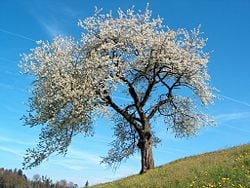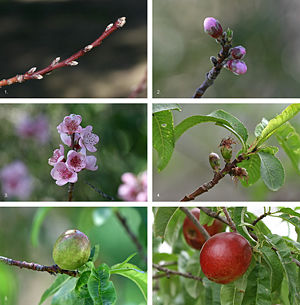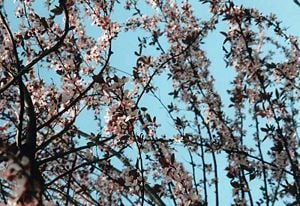Prunus
| Prunus | ||||||||||||||
|---|---|---|---|---|---|---|---|---|---|---|---|---|---|---|
 Prunus cerasus (sour cherry) in bloom
| ||||||||||||||
| Scientific classification | ||||||||||||||
| ||||||||||||||
|
see text |
Prunus is an economically important genus of deciduous and evergreen trees and shrubs, characterized by a fruit in the form of a drupe, usually white to pink perigynous flowers with five petals and five sepals, simple leaves, and often the production of cyangogenetic glycosides in the seeds and leaves. There are around 430 species in this genus, mainly spread throughout the northern temperate regions of the globe. This genus includes the plums, cherries, peaches, apricots, and almonds.
These genus includes species highly valued for their fruit, as ornamentals, and for timber.
Overview and description
It is traditionally placed within the rose family Rosaceae as a subfamily, the Prunoideae (or Amygdaloideae), but sometimes placed in its own family, the Prunaceae (or Amygdalaceae).
The flowers are usually white to pink, with five petals and five sepals. They are borne singly, or in umbels of two to six or sometimes more on racemes. The fruit is a drupe (a "prune") with a relatively large hard coated seed (a "stone"). Leaves are simple and usually lanceolate, unlobed and toothed along the margin.
Many species produce hydrogen cyanide, usually in their leaves and seeds. This gives a characteristic taste in small (trace) quantities, and becomes bitter in larger quantities. [3]
Etymology
The word is infrequent in original Latin. Pliny uses prūnus silvestris to mean the blackthorn. The English word prune is derived from the same source.
The Online Etymological Dictionary presents the customary derivations of plum and prune from Latin prūnum, the plum, which is frequent in a number of authors, including Pliny. The word is not native Latin, but is a loan from Greek προῦνον (prounon) which is a variant of προῦμνον (proumnon), origin unknown. Most dictionaries follow Hoffman, Etymologisches Wörterbuch des Grieschischen, in making it a loan from a pre-Greek language of Asia Minor, related to Phrygian.
The Latin word prūnus and Greek word προύμνη (proumnē) refer to the plum tree.
The first use of Prunus as a genus name belongs to Linnaeus in Hortus Cliffortianus of 1737, which went on to become Species Plantarum. In that work Linnaeus attributes the word to "Varr.", who it is assumed must be Marcus Terentius Varro.
Classification
Linnean classification
In 1737 Linnaeus used four genera to include the species of modern Prunus — Amygdalus, Cerasus, Prunus and Padus — but simplified it to Amygdalus and Prunus in 1758. Since then the various genera of Linnaeus and others have become subgenera and sections, as it clearer that all the species are more closely related. Liberty Hyde Bailey says:
- "The numerous forms grade into each other so imperceptibly and inextricably that the genus cannot be readily broken up into species."[1]
Modern classification
A recent DNA study of 48 species concluded that Prunus is monophyletic and is descended from some Eurasian ancestor.[2]
Historical treatments break the genus up into several different genera, but this segregation is not currently widely recognised other than at the subgeneric rank. ITIS recognises just the single genus Prunus, with an open list of species,[3] all of which are shown in the box on the right.[4]
One standard contemporaneous treatment of subgenera derives from the work of Alfred Rehder in 1940. Rehder hypothesized five subgenera: Amygdalus, Prunus, Cerasus, Padus and Laurocerasus.[5] To them C. Ingram added Lithocerasus.[6] The six contemporaneous subgenera are described as follows:
- Prunus subgenera:
- Subgenus Amygdalus: almonds and peaches. Axillary buds in threes (vegetative bud central, two flower buds to sides). Flowers in early spring, sessile or nearly so, not on leafed shoots. Fruit with a groove along one side; stone deeply grooved. Type species Prunus dulcis (Almond).
- Subgenus Prunus: plums and apricots. Axillary buds solitary. Flowers in early spring stalked, not on leafed shoots. Fruit with a groove along one side; stone rough. Type species Prunus domestica (Plum).
- Subgenus Cerasus: cherries. Axillary buds single. Flowers in early spring in corymbs, long-stalked, not on leafed shoots. Fruit not grooved; stone smooth. Type species Prunus cerasus (Sour cherry).
- Subgenus Lithocerasus: dwarf cherries. Axillary buds in threes. Flowers in early spring in corymbs, long-stalked, not on leafed shoots. Fruit not grooved; stone smooth. Type species Prunus pumila (Sand cherry).
- Subgenus Padus: bird cherries. Axillary buds single. Flowers in late spring in racemes on leafy shoots, short-stalked. Fruit not grooved; stone smooth. Type species Prunus padus (European bird cherry).
- Subgenus Laurocerasus: cherry-laurels. Axillary buds single. Flowers in early spring in racemes, not on leafed shoots, short-stalked. Fruit not grooved; stone smooth. Mostly evergreen (all the other subgenera are deciduous). Type species Prunus laurocerasus (European cherry-laurel).
Another recent DNA study[5] found that Amygdaloideae can be divided into two clades: Prunus-Maddenia, with Maddenia basal within Prunus, and Exochorda-Oemleria-Prinsepia. Prunus can be divided into two clades: Amygdalus-Prunus and Cerasus-Laurocerasus-Padus. Yet another study adds Empectocladus as a subgenus to the former.[7]
Uses
The genus Prunus includes the almond, apricot, cherry, peach and plum, all of which have cultivars developed for commercial fruit and "nut" production. The edible part of the almond is the seed; the almond seed is a drupe and not a true "nut".
There are also a number of species, hybrids, and cultivars grown as ornamental plants, usually for their profusion of flowers, sometimes for ornamental foliage and shape, occasionally for their bark. These ornamentals include the group that may be collectively called flowering cherries (including sakura, the Japanese flowering cherries).
Other species such as blackthorn are grown for hedging, game cover, and other utilitarian purposes.
The wood of some species is a minor and specialised timber (cherry wood), usually from larger tree species such as the wild cherry.
Many species produce an aromatic resin from wounds in the trunk; this is sometimes used medicinally. There are other minor uses, including dye production. [4]
Pygeum is a herbal remedy containing extracts from the bark of Prunus africana. It is used as to alleviate some of the discomfort caused by inflammation in patients suffering from benign prostatic hyperplasia.
Because of their considerable value as both food and ornamental plants, many Prunus species have been introduced to parts of the world to which they are not native, some becoming naturalised.
Prunus species are used as food plants for the larvae of a large number of Lepidoptera species (butterflies and moths); see List of Lepidoptera which feed on Prunus.
Species
|
Old World:
|
|
New World:
|
Palaeobotanical models
The earliest fossil Prunus are wood, drupe and seed and a leaf from the middle Eocene of the Princeton Chert of British Columbia.[8] Using the known age as calibration data, recent research by Oh and Potter[9] reconstructs a partial phylogeny of some Rosaceae from a number of nucleotide sequences. According to this study Prunus and its "sister clade" Maloideae (apple subfamily) diverged at 44.3 mya (well before most of the Primates existed). This date is within the Lutetian, or older middle Eocene.[10] Stokey and Wehr report:[8] "The Eocene was a time of rapid evolution and diversification in Angiosperm families such as the Rosaceae ...."
The Princeton finds are among a large number of Angiosperm fossils from the Okanagan Highlands dating to the late early and middle Eocene. Crataegus is found at three locations: Mcabee, Republic and Princeton, while Prunus is found at those locations and Quilchena and Chuchua. A recent recapitulation of research on the topic[11] reports that the Rosaceae were more diverse at higher altitudes. The Okanagan formations date to as early as 52 mya, but the 44.3 mya data, which is approximate, depending on assumptions, might still apply. The authors assert: "... the McAbee flora records a diverse early middle Eocene angiosperm-dominated forest."[12]
Notes

- ↑ Bailey, page 181.
- ↑ Bortiri and others.
- ↑ Do a search in the ITIS database on the scientific name Prunus for its current list.
- ↑ Other established species appear in the box as well, which for whatever reasons are not yet in ITIS.
- ↑ 5.0 5.1 Sangtae Lee and Jun Wen, A phylogenetic analysis of Prunus and the Amygdaloideae (Rosaceae) using ITS sequences of nuclear ribosomal DNA, American Journal of Botany. 2001;88:150-160. This article summarizes the classification of Prunus and gives additional data derived from chemical analysis. It may be found online at [1].
- ↑ Stone Fruits, article by William Okie submitted to the Encyclopedia of Fruits and Nuts in July 2003. Summary and Abstract are available at [2], a USDA Reasearch site.
- ↑ Bortiri, Esteban and Oh, Sang-Hun; Gao, Fang-You; Potter, Dan (2002). The Phylogenetic Utility Of Nucleotide Sequences Of SORBITOL 6-PHOSPHATE DEHYDROGENASE In Prunus (Rosaceae). American Journal of Botany 89 (11): 1697–1708. The specification is Emplectocladus (Torr.) Sargent
- ↑ 8.0 8.1 Stockey & Wehr (1996) pages 241 and 245.
- ↑ Oh, Sang-Hun and Potter, Daniel (2005). Molecular phylogenetic systematics and biogeography of tribe Neillieae (Rosaceae) using DNA sequences of cpDNA, rDNA, and LEAFY1. American Journal of Botany 92: pages 179–192.
- ↑ A date of 76 mya is given for Rosaceae, which is within the late Cretaceous.
- ↑ Dillhoff, Richard M and Leopold, Estella B.; Manchester, Steven R. (February 2005). The McAbee flora of British Columbia and its relation to the Early-Middle Eocene Okanagan Highlands flora of the Pacific Northwest. Canadian Journal of Earth Sciences 42 (2): pages 151–166.
- ↑ Page 165.
Bibliography
- Bailey, Liberty Hyde (1898). Sketch of the Evolution of Our Native Fruits. New York: The MacMillan Company.
- Bortiri, Esteban; and others (2001), "Phylogeny and Systematics of Prunus (Rosaceae) as Determined by Sequence Analysis of ITS and the Chloroplast trnL-trnF Spacer DNA", Systematic Botany 26 (4): pages 797–807 . Abstract and first page for free.
- Linnaeus Carolus; Sprengel, Curtius (editor) (1830). Genera Plantarum Editio Nona. Gottingen: Dieterich. For Prunus see page 403.
- Stockey, Ruth A. & Wehr Wesley C. (1996), "Flowering Plants in and around Eocene Lakes of the Interior", in Ludvigson, Rolf, Life in Stone: a Natural History of British Columbia's Fossils, Vancouver: UBCPess, at page 234 following, ISBN 0774805781 .
See also
- Blossom
- Fruit tree
- Leaf
- List of botanists by author abbreviation
External links
- Partial Prunus species listing: by National Genetics Resources Program
—>
Credits
New World Encyclopedia writers and editors rewrote and completed the Wikipedia article in accordance with New World Encyclopedia standards. This article abides by terms of the Creative Commons CC-by-sa 3.0 License (CC-by-sa), which may be used and disseminated with proper attribution. Credit is due under the terms of this license that can reference both the New World Encyclopedia contributors and the selfless volunteer contributors of the Wikimedia Foundation. To cite this article click here for a list of acceptable citing formats.The history of earlier contributions by wikipedians is accessible to researchers here:
The history of this article since it was imported to New World Encyclopedia:
Note: Some restrictions may apply to use of individual images which are separately licensed.


